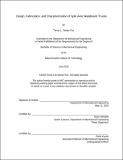Design, fabrication, and characterization of split axle skateboard trucks
Author(s)
Winter Fox, Terran L
DownloadFull printable version (1.845Mb)
Other Contributors
Massachusetts Institute of Technology. Department of Mechanical Engineering.
Advisor
Dawn Wendell.
Terms of use
Metadata
Show full item recordAbstract
A new design for skateboard trucks has been developed and tested in an effort to reduce the uncomfortable vibration experienced when riding a skateboard. The new design interfaces with existing hardware but also features a split axle geometry which allows the left and right wheels to move independently. In order to determine whether the split axle trucks improved rider comfort, the trucks were tested on a skateboard outfitted with sensors that measure acceleration normal to the road surface. Similar measurements were taken with standard skateboard trucks to serve as a control. Multiple trials were run at each of three different test speeds over a set course. Results showed that the majority of the dominant vibration frequencies are in the range of 20-450 Hz for both truck designs. The magnitude of the peak acceleration and the arms were observed to increase faster with speed for the standard truck design, and at the highest speed of 20 km/h the split axle design was shown (with 95% certainty) to have a peak acceleration which was 96 m/s2 lower than that of the standard truck. Overall the results suggest that the new split axle design primarily improves rider comfort during localized vibration events by reducing the peak acceleration that is experienced. This effect, along with a reduction in the measured arms, become increasingly apparent at higher speeds.
Description
Thesis: S.B., Massachusetts Institute of Technology, Department of Mechanical Engineering, 2018. This electronic version was submitted by the student author. The certified thesis is available in the Institute Archives and Special Collections. Cataloged from student-submitted PDF version of thesis. Includes bibliographical references (pages 30-31).
Date issued
2018Department
Massachusetts Institute of Technology. Department of Mechanical EngineeringPublisher
Massachusetts Institute of Technology
Keywords
Mechanical Engineering.